Oil is bringing in more money than gas, but as shale plays proliferate, high-spec, high-horsepower rigs might reach 100% utilization before newbuilds can help.
Richard J. Mason, The Land Rig Newsletter
The US land drilling market is poised to repeat 2006, as sharply higher demand for drilling services rapidly consumes available land rigs. If second-quarter 2008 trends continue, the onshore market will exhaust the supply of available units in most rig classes by the time fall arrives. In fact, demand for 1,500-hp units exceeds capacity. A similar story is developing for 1,000-hp units.
Both classifications comprise the greatest volume of newbuilds in the post-2005 retooling cycle. In all, more than 640 rigs were added to the fleet between 2004 and 2007, according to Fort Worth-based RigData, including 222 units in the 1,000 to 1,499-hp range, and 140 units in the 1,500 to 1,999-hp range. Projections earlier in 2008 called for the industry to add 50 newbuilds in these two categories to the domestic fleet this year, although recent newbuild announcements have increased this total to 75 rigs. Additionally, there are announcements for 35 units that do not have horsepower descriptions, though it is assumed the majority will fall in the 1,000 hp or larger category.
OIL PRICES INCREASE DRILLING
A convergence of factors led to the rapid tightening in the onshore market. The first is gravity-defying commodity prices. A simple calculation that combines Energy Information Administration (EIA) US domestic production with wellhead prices (Fig. 1) indicates monthly revenue flow from oil moved above $21 billion at the end of March 2008. For comparison, oil now generates more domestic revenue flow than oil and gas combined did 18 months ago.
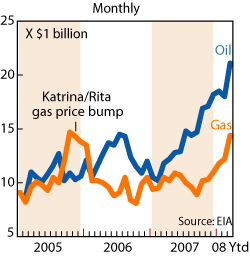 |
|
Fig. 1. Oil and gas revenue.
|
|
Similarly, natural gas revenue flows exceeded $15 billion monthly in April 2008, the last month for which EIA data on production and wellhead pricing is available. Natural gas revenues climbed above the late 2005 price spike following the Katrina/Rita hurricanes. Combined, domestic revenue flow from oil and gas exceeded $35 billion monthly for domestic producers in March 2008, up from $22.3 billion one year prior.
The second factor involves a nascent round of exploration in newly identified shale plays as the unconventional oil and gas paradigm undergoes transformation yet again. Interest in new shale plays took a jump in December 2007 when two academics in the Northeast developed a resource estimate that called for up to 50 Tcf recovery out of the Marcellus Shale in Pennsylvania and New York. Then in February 2008, EOG Resources hosted an analyst day promoting several “stealth” North American shale plays. Shale fever soon ensued, and headlines followed fast and furious as operators scrambled for investor mind-share by announcing ties to the latest shale du jour.
The impact on rig demand will be significant. The most promising new shale play short-term involves the Haynesville in northwest Louisiana. The region is undergoing a land grab as operators scramble for acreage. Initial horizontal tests in second-quarter 2008 were promising, with IP rates ranging from 5.5 to 17 MMcfd (equivalent) at vertical depths between 11,000 and 13,000 ft, and horizontal laterals extending 3,500 ft. Symptomatic of the play is the remarkable $3.3 billion joint venture involving Plains Exploration & Production Co. and Chesapeake Energy Corp., in which Plains will pay $1.65 billion in cash for 20% of Chesapeake’s 550,000-acre Haynesville leasehold, and will underwrite $1.65 billion in drilling expenses for as many as 600 wells in the play over the next three years. This implies a need for 50 additional rigs in the 1,500-hp or larger category.
The only problem is that 50 spare, 1,500-hp rigs do not exist in the US market, and many of the existing rigs in this category are under multi-year contracts. The implications are that the industry needs to build 15 or more of these rigs annually at costs that now approach $17 million each, depending on configuration. Other operators with prospective Haynesville acreage are also discussing expanded drilling programs over the next couple years.
Even without the new shale plays, demand for drilling services is strong across the board, thanks to stellar commodity prices. During 2007, new rig additions displaced older rigs and somewhere between 300 and 400 units stacked out, depending on who compiled the tallies. Consequently, marketed fleet remained in a narrow band between 2,250 and 2,300 units for the second half of 2007, even as new rigs entered the fleet, Fig. 2. Activity moved decisively higher in the second quarter of 2008. Rig employment increased at an average rate of two rigs a day during the period and rig utilization in June 2008 topped the 80% level fleet-wide, the point at which rig pricing historically responds in a rising market, Fig. 3.
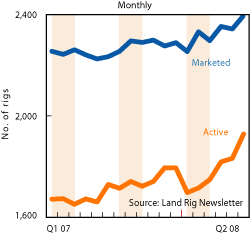 |
|
Fig. 2. During 2007, new rigs displaced older rigs, resulting in a nearly flat marketed fleet size.
|
|
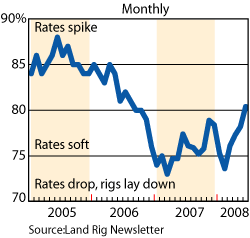 |
|
Fig. 3. Rig utilization increased at an average rate of two rigs a day, topping 80% in June.
|
|
DIFFERENT METHODS
Cash flows from oil and gas revenues impact various segments of the oil and gas operating community differently. At the risk of oversimplification, it is possible to develop a generalized model that speaks to how energy prices influence demand for drilling rigs. For example, higher oil revenues aggregate, in general, toward two groups, one of which includes the majors, such as ExxonMobil, Chevron and other players like Occidental. One of the characteristics of this class of operator is relative stability in rig count. The majors employ about the same number of rigs all the time regardless of commodity price. So the initial run up in oil prices in late 2007 had little influence on rig count from this group.
However, rising oil revenues also benefit a second class of operator, the small, privately-held oil and gas company. Members of this group have been colorfully described as “checkbook operators”-a term that illustrates the fact that group members operate out of cash flow. This group historically displays seasonality in rig employment, as operators in this class dust off prospects and arrange financing in the first half of the year, then begin checking rig availability about mid-year, and embark on a three-to-five well drilling program in the final portion of the year. This behavior pattern accounts for the pronounced seasonality evident in land rig counts.
One defining characteristic of this class is the lack of critical mass to participate in the large resource plays, which require large upfront capital expenditures for acreage acquisition and exploitation. Consequently, the post 2004 movement towards broad-based unconventional gas plays in the domestic land market has favored large independents while small, privately held operators have been relegated to marginal areas of the market typically associated with shallower drilling, lower spec rigs, and oil-dominated prospects. As a result, this group tends to be highly sensitive to commodity prices on the one hand, and field costs on the other.
Apparently, it is the best of all possible worlds for the checkbook operator. The cash flow from the steep run up in oil revenues at the end of 2007 began arriving in bank accounts during the first quarter of 2008, while rig rates remained flat. Those circumstances were followed by a sharp increase in rig employment among this group in the second quarter of 2008. For comparison, aggregate rig count for privately held companies averaged 702 units in the first quarter of 2007, and ultimately peaked at 805 units during last quarter of 2007. That quarterly average fell back to 702 units in first-quarter 2008, repeating the seasonal historical pattern, then unexpectedly increased 10%, or 73 units, to 775 in the second quarter of 2008, and was moving above 800 units by June 2008, Fig. 4. This group accounted for half of the increase in rig count during second-quarter 2008.
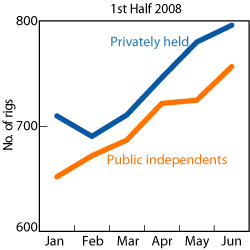 |
|
Fig. 4. Rig counts by classification.
|
|
Similarly, rising natural gas revenues have a greater influence on the publicly held independents. This segment is tied more closely to natural gas, particularly because of a growing involvement in the unconventional oil and gas play that has dominated US drilling activity after 2004. This article, in previous issues of World Oil (August 2006, August 2007) has chronicled the split in operator objectives for conventional and unconventional drilling in the domestic US, resulting in market bifurcation.
Unconventional oil and gas exploitation is evident in the increase in non-vertical drilling as a percentage of all drilling (Fig. 5), a tendency to employ higher spec rigs in more difficult drilling environments and an expansion in aggregate rig count for larger oil and gas companies. Those programs often feature hedging, which underwrites broad-based development efforts, and which financed the construction of newbuild, fit-for-purpose drilling rigs through multi-year term contracts during the 2005-2007 period.
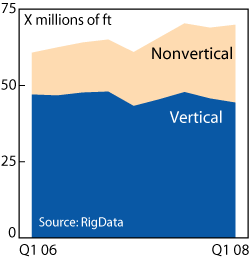 |
|
Fig. 5. Horizontal/directional drilling as a fraction of all footage drilled.
|
|
Cash flows from rising natural gas prices lagged the run up in oil prices by 90 days, as late winter cold weather in the Midwest prompted a steep drawdown in gas storage after mid-February 2008. Natural gas finished the winter season with 1.2 Tcf in the ground, which is considered bullish for the industry. Natural gas prices subsequently responded to market signals, moving above $9 per Mcf in late February, and above $10 in April. The new pricing climate prompted the large and mid-cap independents to revise capital expenditures sharply upwards. Operator spending surveys at Lehman Brothers, for example, found domestic capex moving upward, from mid-single digit expectations at the end of 2007, to 15-20% at mid-year.
In short, everybody wanted a drilling rig as second-quarter 2008 arrived. What makes the present market similar to the 2006 cycle is that all rigs classes are in demand. For example, the assumptions are that smaller operators will employ lower spec rigs for conventional, vertical oil-biased targets, while larger independents will seek higher spec rigs for more technically demanding non-vertical drilling in unconventional gas formations. In fact, rig employment went up in both the sub-1,000-hp category and the 1,000 to 1,999-hp category in second-quarter 2008, Fig. 6.
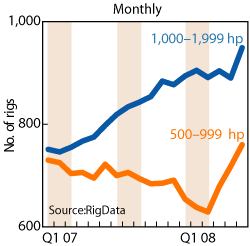 |
|
Fig. 6. Rig counts by horsepower.
|
|
More important is the sharp climb in rig employment during the second quarter, which has reduced idle capacity. According to RigData, rig count for sub-500-hp rigs peaked at 304 units near the end of 2006, and then dropped to 188 units at the cycle’s trough, implying that 116 rigs were idled. Rig count in this classification has since recovered to 233 units active at the end of June. Similarly, rig count for 500 to 999-hp units also peaked in late 2006, at 797, and then fell to 615, implying roughly 180 stacked rigs. These mid-sized rigs had recovered to 750 by the end of June. That leaves a spare capacity of four or five dozen 500 to 999-hp units to meet rising demand.
Conversely, new rig construction expanded capacity for 1,000-hp units with the industry adding 90 rigs in this classification after 2006, and more than 130, 1,500-hp rigs. There is little, if any, spare capacity, and demand for rigs in these higher spec classifications will have to be met by newbuilds.
The second half of 2008 holds potential for a couple scenarios. The first is that the industry is witnessing a phenomenon whereby a commodity price spike in both oil and natural gas has moved rig demand upward. The second half of the year will likely be dependent on the extraordinary volatility in prices.
The other possibility is that the strong surge in domestic cash flows will result in additional demand for rigs, over and above present levels, exhausting the supply of available rigs and re-creating market conditions last seen in 2006, both in terms of rapidly inflating rig prices and a scramble to build new units to meet greater demand for drilling services. If drilling demand stays strong, rig prices should respond in the August/September time period, as contracts are put in place for year-end 2008 drilling. There are practical limits to the expansion rate in rig count. Market constraints at mid-summer included tightening supplies in Oil Country Tubular Goods (OCTG) and the pending full utilization of higher spec rigs. 
|
THE AUTHOR
|
|
|
Richard Mason is publisher of The Land Rig Newsletter, a monthly publication that provides trends analysis for the land-based contract drilling sector of the oil and gas industry. He previously worked 10 years as a field historian for the Texas Tech University archives, collecting historical materials on petroleum, agriculture and irrigation development in the American Southwest. Mr. Mason is a 1974 graduate of Ohio University with a bachelor of arts degree, with honors, in history.
|
|
|









